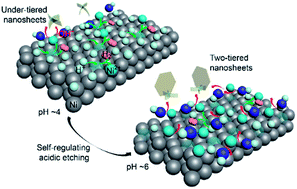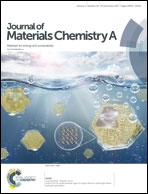High-efficient electrocatalysts by unconventional acid-etching for overall water splitting†
Abstract
Recent advances in doping and heterostructuring based on earth-abundant two-dimensional nanoframeworks provide new possibilities in electrocatalysis. In this study, a novel, unconventional, one-step self-regulating acid-etching strategy was developed to prepare two-tiered hierarchical Fe-doped and Pt-decorated nickel hydroxide nanosheets selectively for efficient oxygen evolution and hydrogen evolution reactions. The combinatorial hydrolysis of Ni ions in a self-limiting acidic environment induces selective growth of disparate dimension nanosheets. The proposed strategy, avoiding multifold structural design challenges, delivers highly exposed active sites and robust catalyst/support interfaces. Moreover, the exquisite structure and synergetic heterostructure modulation afford kinetically favorable electrolyte mass transport, and gas bubble release. Consequently, the structurally well-designed and hetero-coordinated electrodes attest highly efficient oxygen evolution with a low Tafel slope of 70.6 mV dec−1 and overpotential of 300 mV at a current density of 10 mA cm−2, while it 30.4 mV dec−1 and 37 mV for hydrogen evolution, which rival performances of state-of-the-art electrocatalysts.

- This article is part of the themed collection: 2017 Journal of Materials Chemistry A HOT Papers


 Please wait while we load your content...
Please wait while we load your content...